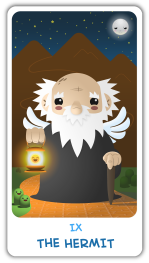Every once in a while, I get the honor and privilege to help make a difference in someone’s life. Today is one of those days. Meet Mr. Adam Blodgett. A writer and graphic/web designer from Olympia, Washington, Blodgett is a man with extraordinary vision, talent, and energy. So when I heard this guy was producing his very own Tarot cart deck, I had to learn more.
Andrew: Yo Adam, I hear you’re developing your own set of Chibi Tarot. Sounds cool, but what is it?
Blodgett: The Chibi Tarot is a traditional tarot deck reflected through the super-cute lens of chibi. It reflects two of the major influences in my life: the Western occult tradition of magic as represented by the tarot, and the influence of contemporary east Asian culture through video games, anime and manga.
Andrew: Is there a precedent for using non-traditional figures within the tarot cards? Will the Chibi Tarot deck have the usual suspects, such as the Devil, the Hermit, etc., or are you renaming the deck as well?
Blodgett: Defintely. The world of tarot is wide and varied. There’s a long tail of decks that most folks will never see, but when you start exploring sites like Aeclectic Tarot ( http://www.aeclectic.net/tarot/cards/tarott10.shtml ) you’ll see that there are hundreds of interpretations on the tarot. That’s one of the attractive things about the deck: there’s no one true tarot, and its boundaries can be shifted and shaped to meet our needs wherever we’re at.
Nope, not renaming the deck. The Chibi Tarot will be similar to what’s called a Waite Smith clone.
“Decks whose cards generally have illustrations similar to those in the Waite-Smith Tarot, often maintaining the faux-medieval setting, but often discarding much of the occult symbolism.“
My three main inspirations for the deck are the Waite Smith, the Aleister Crowley’s Thoth tarot and the Tarot of Marseilles. I’m using those three decks and the foundational inspirations, and then weaving in my own style over their “bones”.

Andrew: What prompted your interest in Tarot and then in creating your own?
Blodgett: Hm, that’s an interesting question. I’ve always been aware of the tarot, but growing up Christian it was more in a “things to stay away from because they’re the tools of the devil” sense. As I grew out of my Christian upbringing I that taboo wore away, and in the mid-2000s I took a course with T Thorn Coyle in the Bay Area. We needed our own oracle for the class, and the tarot was the one I was most familiar with. So I went out and bought the traditional Waite Smith deck (http://en.wikipedia.org/wiki/Rider-Waite_tarot_deck) which I was immediately disappointed with. It didn’t resonate with me at all, the illustrations were stilted and awkward, the colors were funny. So I went on AeclecticTarot.comand went through EVERY SINGLE deck on there and picked out my favorites and ended up with the Tarot of Origins, by renowned Italian illustrator and comicker Sergio Toppi.
As for creating my own, I never planned on it. As an artist and designer I’ve always been looking for an idea that had legs, something that I could develop into a property. That seems a bit crude at first, but I’m really interested not only in the creation of the world, but in the marketing and production aspects of it as well. The Chibi Tarot wasn’t my first try at creating something like this. There have been many previous attempts, comic strips and characters that never really made it off the page. The genesis of this particular idea was more of a whim than anything. It was, “Can I simplify the tarot? Can I make it a cartoon?” so I sat down and I drew the Death card. It didn’t take me more than a couple of hours on the computer. I was looking for something that was innovative and interesting but not exhaustively time consuming. Little did I know how far it would take me and how much time it would take up!
Andrew: What goes into creating a deck of Tarot cards, especially one as unique and personal as the Chibi?
Blodgett:A lot! Generally I’ll work with the card’s concept or definition, reading through the tarot books I use (Rachel Pollock’s 78 Degrees of Wisdom and Robert Place’s The Tarot: History Symbolism and Definition are indispensable for me). Once I’ve got the concept I can begin on the image itself in my sketch book, trying to realize the concept as best I can. I work really hard to simplify as much as possible, since that’s really the essence of the deck: Keeping the images simple and cute. Once I’ve captured the image with pencil and paper I’ll take a photo of it and send it the computer and set up in Adobe Illustrator. I’ll lay the photo of the drawing down and basically trace over it with various tools in Illustrator. Once I’ve got the outlines (I do them in blue in homage to traditional artists who use blue pencil so it doesn’t get picked up in the photocopying process) I’ll move in on the detail. Lastly, I’ll spend a day or so wrestling with the colors. Colors are ABSOLUTELY the part I struggle with the most. I am incredibly unskilled in colors and I’ve learned a lot doing this deck. I also steal a lot of colors from other folks so I can learn how they’re putting together their palettes.
As for completion dates, 11 of the cards are finished and four of them are in process, which leaves 8 cards left to do. If we just raise the $5,000 I foresee finishing the deck around the New Year, and then manufacturing it in January/Februrary and having it available for backers by March of 2013. But, the more money we raise, the more work I’ll be able to do on the deck and the sooner it will be in your hands!


